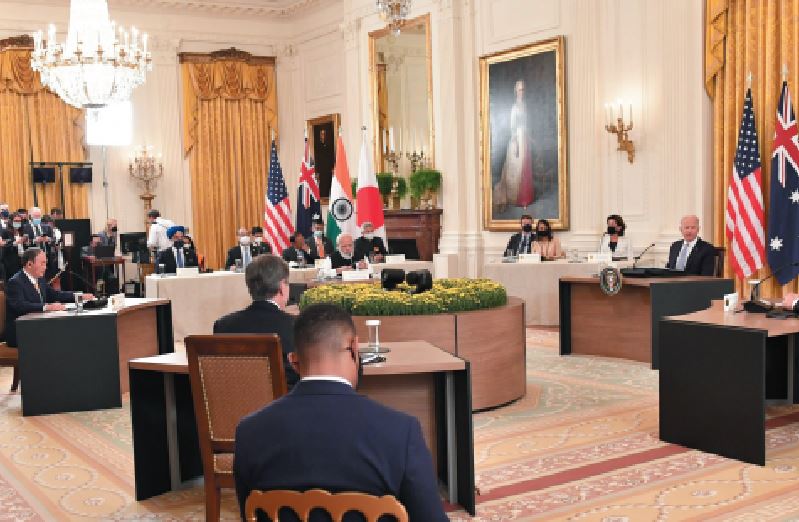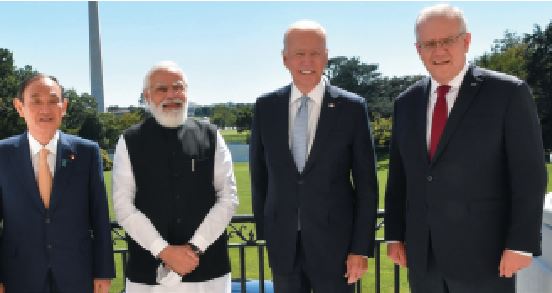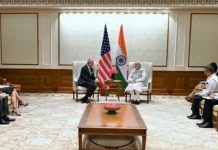
In his talks with President Biden, PM Modi was reportedly in a posture and delivery that seemingly appeared restrained and devoid of any kind of informality. PM Modi spoke extempore with a bit of gushing praise for his host, while President Biden read off his statement from cue-cards sans any effusive touch to his remarks.
Much-hyped recent three-day visit of Prime Minister Modi to the United States coincided with the convening of the 76th Session of the UN General Assembly, in-person meeting of the Heads of Government of the Quad member countries and concretization of friendly relations between New Delhi and Washington. Nevertheless, Indo-US relations enjoyed pre-eminence over other two momentous events. Undoubtedly, three-day visit is too short a period for a visiting Prime Minister to garner support from all quarters to his viewpoint, especially in a ‘New Norm’ that has come to prevail in the aftermath of the devastation wreaked by the second wave of the COVID-19, nonetheless, it does afford ample opportunity to meet one’s counterparts from other major powers of the globe and exchange notes on multilateral and bilateral issues.
The focus of the visiting Indian Prime Minister was seemingly on practical issues pertaining specifically to Indo-US relations, Afghanistan and Afg-Pak region, the Quad, COVID-19 vaccination, climate change and the issues related to the United Nations. Unlike the Indian media where PM Modi’s visit hogged headlines, the response of the American media was almost lukewarm. Some critics have opined that the PM Modi’s recent US visit under the Biden Administration lacked the theatrical flavour it had during the Administration of Donald Trump.
Address to UN General Assembly
Address to the UN General Assembly is almost a routine annual affair for every head of the State or Government of each country and to this, India is no exception. However, the 76th session of the UN General Assembly assumes significance because of a suite of global developments that have taken place in the wake of impending problem of COVID-19 and availability of vaccination for developing and least developed countries, situation in Afghanistan, forthcoming COP-26, developments in the Indo-Pacific region and other related global and regional issues. PM Modi’s address to the 76th session of the UN General Assembly did dwell on some of the burning problems confronting the global community, especially availability of the vaccination for COVID-19 and India’s decision to export/donate over seven million vaccinations for COVID-19 etc., has been welcomed.
However, PM Modi’s allusion to personal biographical details at the global platform like the UN General Assembly seldom augurs well for either India’s traditions and performance of the past prime ministers who happened to address such sessions of the UN General Assembly.

Quad Meeting
Quad was formed in 2004 with Australia, India, Japan and the United States as its founding members with a view to ensure the safety, security, and well-being of Asia-Pacific region. Over the years, Quad members have been engaged in various military exercises in the Indo-Pacific region and some analysts also call it ‘Asian NATO.’ On 24 September, Washington hosted the first in-person Quad summit and it was structured around four main themes; Climate, Technology and Cyber Security; COVID-19 response; and Afghanistan and regional security. President Biden reiterated the common vision of the “democratic partners” to the “key challenges of our age, from COVID-19 to climate to emerging technologies.”
The Quad leaders agreed to launch a Semiconductor Supply Chain Initiative, support 5G deployment and diversification; launch a Quad Senior Cyber Group; sharing satellite data to protect the Earth and its waters; and launching of the Quad fellowships for 100 students every year. India’s decision to export vaccine was welcomed by all Quad members. At the end of the summit, the members adopted a document on Quad Principles on critical and emerging technologies. All the Quad members present at the summit pledged to ensure “free” and “inclusive” Indo-Pacific. The Joint Statement expressed the commitment of summit leaders to provide rule-based order that is rooted in international law in bolstering the security and prosperity of the region.
Outcome of the Visit
The first bilateral dialogue between US president Joe Biden and visiting Indian PM Modi, held on 24 September, covered a wide range of issues including the evolving situation in Afghanistan, counter-terrorism, COVID-19, defence cooperation and other issues of mutual interests. In his talks with President Biden, PM Modi was reportedly in a posture and delivery that seemingly appeared restrained and devoid of any kind of informality. PM Modi spoke extempore with a bit of gushing praise for his host, while President Biden read off his statement from cue-cards sans any effusive touch to his remarks. According to one analyst, Biden reading off from cue cards was probably indicative of his lack of familiarity with issues pertaining to India and it was also indicative of the “lower priority” that Biden “assigns to New Delhi notwithstanding the public postures.”
From the American side, the focus in bilateral dialogue was on the COVID-19 pandemic, climate change” and the Indo-Pacific region. Nevertheless, in his exchange of views with the US Vice-President Kamala Harris on 24 September prior to his meeting with the US President as well as during the course of his meeting with President Joe Biden the same day, PM Modi had put across Indian point of view on bilateral and global issues along with India’s desire to become a technology and trade partner and with India playing a complimentary role. Visiting Indian Prime Minister also expressed the hope that Indo-US partnership in trade and technology was expected to be a major factor in this relationship in coming decade. Some critics have described Vice-President Harris’s statement, to what they call a “sermon”, when she said that as democracies around the world were under threat, “it is imperative that we defend democratic principles and institutions within our respective countries.”
Construed in a broad spectrum in the wake of on-going global developments, especially at a time when the Biden Administration is trying to seek to nuance its relationship with Beijing to one of ‘extreme competition’, India affords ample opportunities and alternative markets for US companies that are disinclined or barred from trading with China and also provide a vast consumer market and skilled labour as well. Unmistakably, the US is the leading player in terms of its defence-related, technological and soft power capabilities and India is destined to gain from its cordial and friendly relations with Washington.
As per media reports, New Delhi and Washington had signed an MOU on Customs Cooperation and another MOU on Health Cooperation was also finalized prior to the commencement of Indo-US talks in Washington. It is further reported that both countries are likely to resume next round of sectoral talks soon and dates for which are being finalized, including the next round of Defence Policy Group, Health Dialogue and Trade Policy Forum; Homeland Security Dialogue; the Joint Working Group on Counter terrorism; and Designation Dialogue. The Industrial Security Agreement, expected to be inked soon, between New Delhi and Washington, is expected to facilitate high-end defence industrial collaboration.
Media reports indicate that there has been a recent announcement of co-developing air-launched Unmanned Aerial Vehicles (UAVs) under the Defence technology and Trade Initiative and this was welcomed by both countries in recent meeting in Washington. Both India and the US are also said to be developing counter-terrorism technologies and are in the process of giving a finishing touch to a Bilateral Framework that would help in efforts to combine drug-trafficking, illicit narcotics production and precursor chemical supply chain. Interestingly, PM Modi during the course of hi recent US visit has tried to redefine the contours of Indo-US relations in terms of 5Ts – Tradition, Talent, Technology, Trade and Trusteeship.
Economic ties between New Delhi and Washington have witnessed an upward trajectory of growth and the US has remained India’s top trading partner for the second time in 2019-2020 that is an indication of enhanced economic ties between the two countries. The bilateral trade between the two countries that stood at $ 87.96 billion in 2018-2019 increased to $ 88.75 billion in 2019-2020. In early September this year, the US Embassy in New Delhi had tweeted that US-India trade in goods demonstrated an increase of 40 per cent in June 2021.
Way Forward
No major breakthrough in Indo-US relations in terms of transfer of defence technology or signing of a major trading or investment deal has been achieved as a sequel to PM Modi’s recent visit to the United States. Intermingling of domestic policies and foreign policy that has been the hallmark of PM Modi’s speeches either in the US or UN General Assembly since 2014 are bound to raise eyebrows and inviting advice or ‘sermon’ from foreign leaders or media and this time it is from Vice-President Harris. There is dire need for India to demonstrate its statesmanship and not mere leadership.
tehelkaletters@gmail.com













